We’ll clean one inverter circuit for you free of charge—or as much as needed for a comparative measurement—in exchange for sharing the change in your yield with us!
Clean solar panel, Clean energy!
With professional solar panel cleaning, you can increase your system’s efficiency by up to 30%.
Cleaning solar panels is a thorough and careful process that ensures maximum efficiency and a long lifespan. Our service is carried out by specially trained professionals to ensure your panels always deliver peak performance.
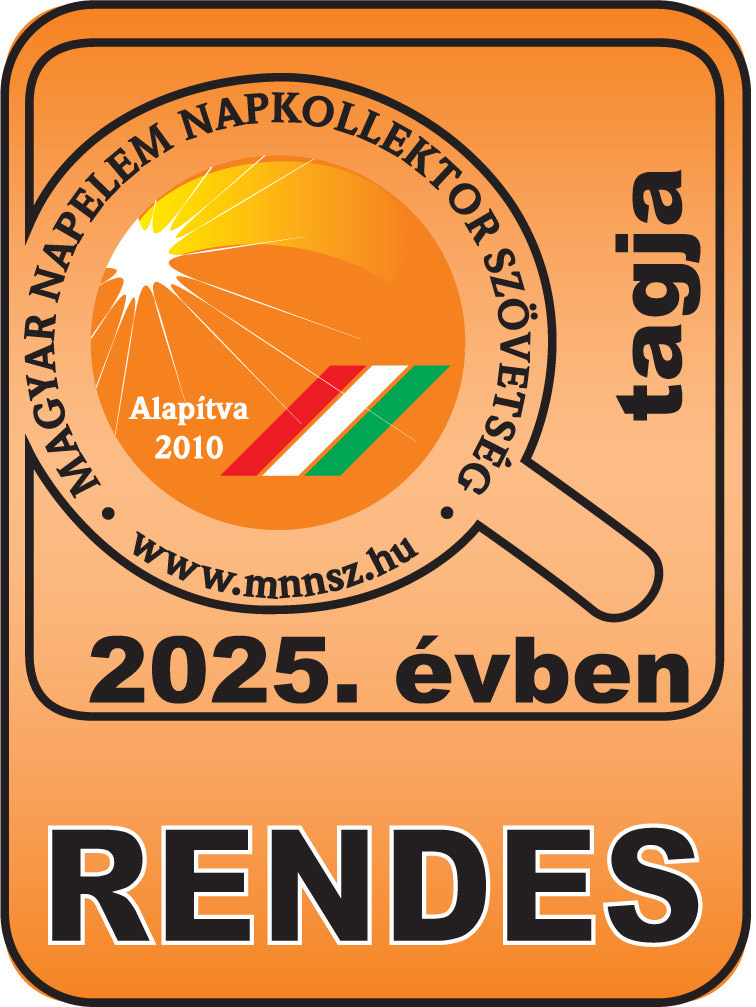
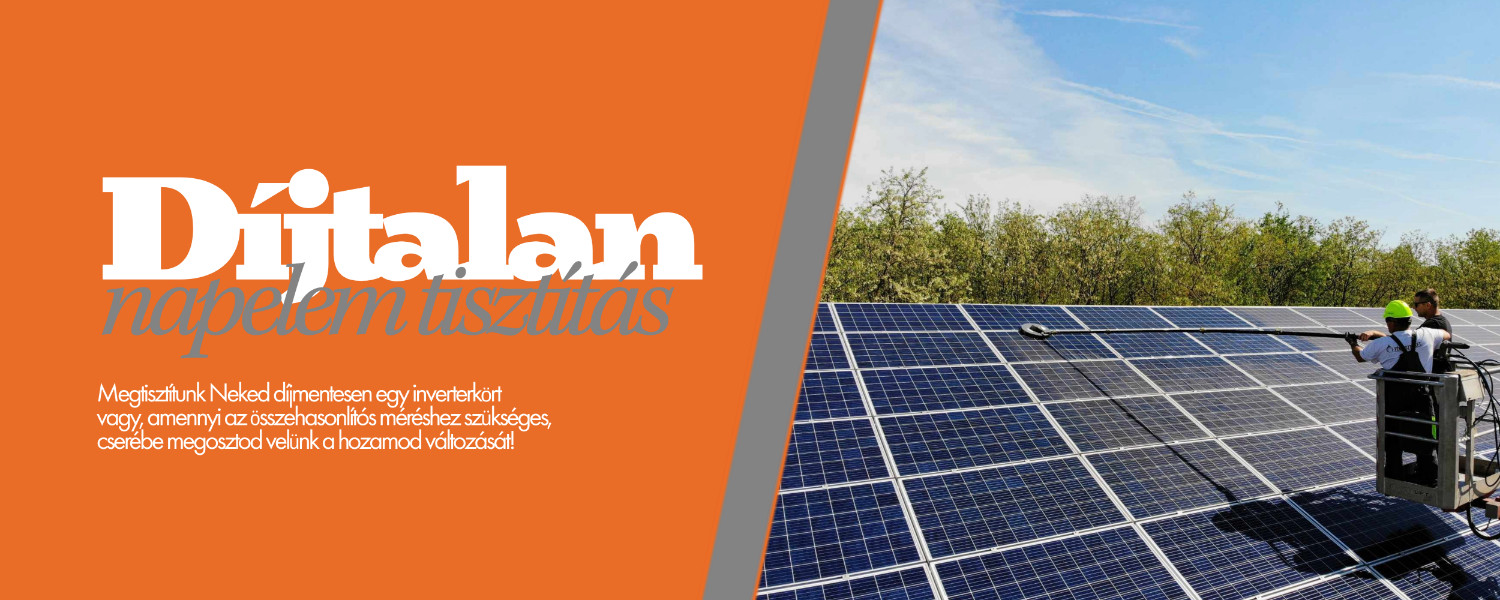
How much does cleaning additional panels cost?
If, based on the comparative measurements following the free cleaning, you decide to order the maintenance of your remaining panels from us, then we offer it at a rate of 120-180 Ft/m2+VAT we offer it at a price including VAT.
CORROSION PROTECTION
What does corrosion protection have to do with solar panels?
The supporting structure of solar panels is usually made of galvanized steel.
Did you know that the zinc coating only protects the metal for about 10 years? After that, maintenance painting is necessary.
Starting corrosion protection in time is far more cost-effective than replacing the entire support structure!
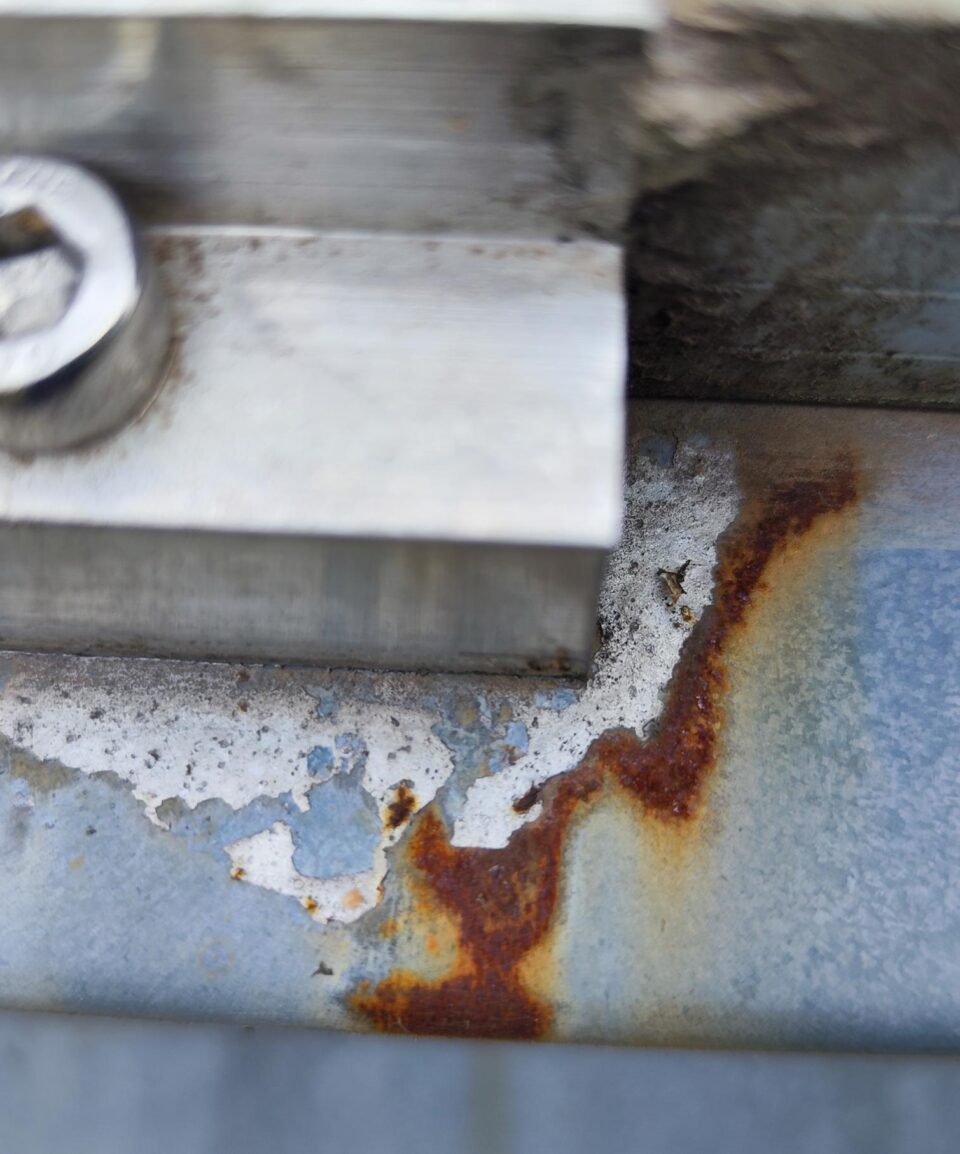

THEGRASS GREW SO MUCH...
…that the solar panel mounting structures are no longer accessible?
We have a solution for that too!
Let’s talk about the details!
Feel free to call or message us!HOW MUCH PRODUCTION INCREASE CAN YOU EXPECT?
I could throw in some big numbers here—like up to …%—but instead, let’s take a look together at the before-and-after difference!
(Based on our own measured experience: 2–10%)
HOW CAN WE MEASURE IT?
How can we measure the effectiveness of cleaning in a solar park with thousands of panels?
The solution is reference inverter-based measurement.
NOTE
In solar parks, to maximize production, it’s common to install more panels than what the inverters’ nominal capacity would suggest. Because of this, the impact of cleaning may not be most noticeable during sunny periods, but rather on overcast days with diffused light.
here's how the method works
Selection
Measurement
Stability
Reliability
A módszer lényege a következő
01
Kiválasztás
Kiválasztunk egy referencia invertert a napelem parkban, amelyhez tartozó napelemeket megtisztítunk.
02
Mérés
A tisztítás előtt és után mérjük a referencia inverter termelésének arányát az össztermeléshez képest.
03
Stabilitás
Több napon keresztül végezzük a méréseket, hogy a változó időjárási körülmények (napsütés, felhőzet, szél) ne befolyásolják az eredményeket.
04
Megbízhatóság
A referencia inverter adatai biztosítják a tisztítás hatásának megbízható mérését.
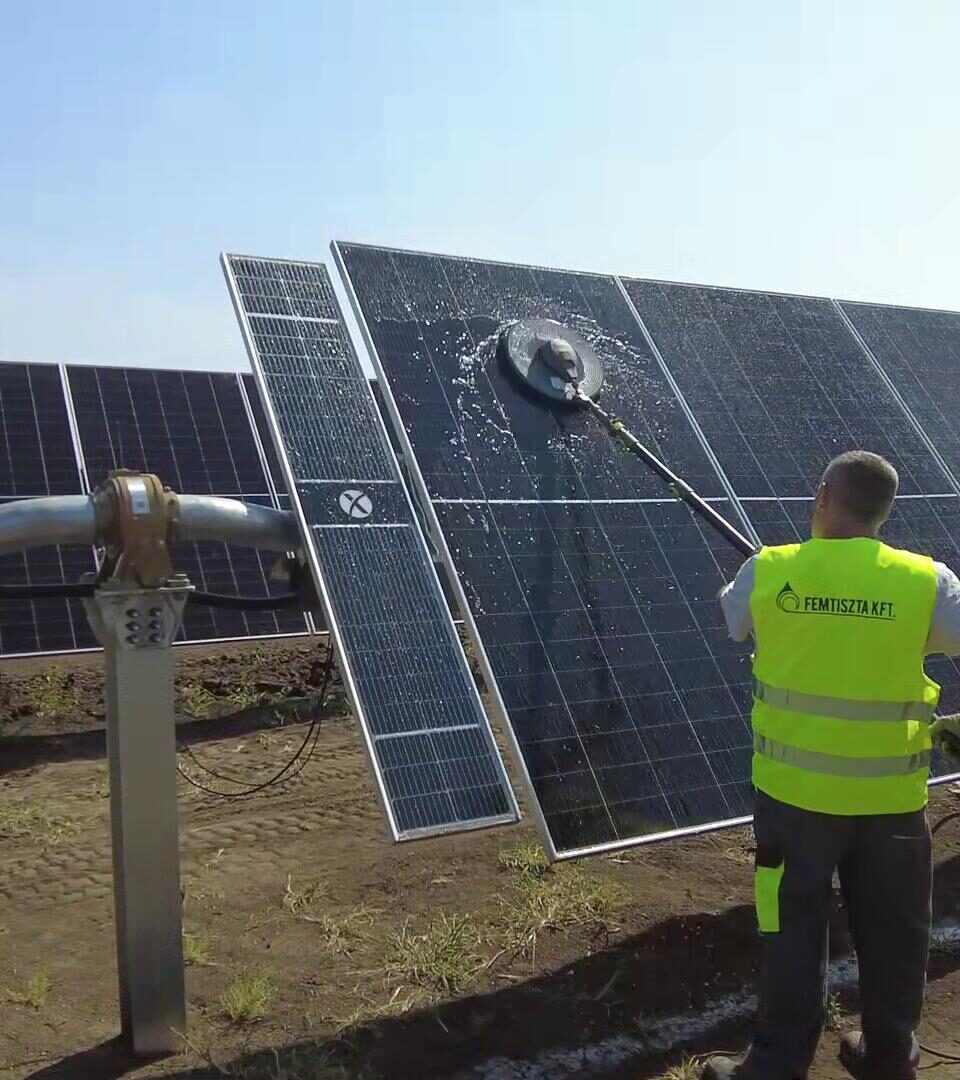
HOW OFTEN SHOULD YOU HAVE YOUR PANELS CLEANED?
There’s no question about whether solar panels need to be cleaned—the real question is how often?
My answer: cleaning always requires an individual assessment.
Because it matters whether...?
Where your panels are located in relation to the highway or busy main roads.
How many bees per square meter appear next to your solar park during the acacia bloom.
Whether there is a lake or river nearby with a large bird population.
Whether there is an industrial facility in your vicinity.

In a few wordsAbout us
Welcome, I’m László Gálfi, the outgoing managing director of Fémtiszta Kft., now in its 33rd year. The company ship has a new captain—my son. He will be steering the wheel for the decades to come. I’m proud of him—he truly knows the trade!
As for me, I now have a different journey ahead!
MY FUTURE PLANS
Armed with three decades of cleaning experience and a strong network, my clear goal is to regularly clean hundreds of thousands more solar panels each year from Hungary’s roughly 16 million panels, which together account for 7,550 MW of capacity (as of January 2025).
In 2025—just as I did last year—I plan to reach out to many power plant owners with a unique and hopefully irresistible offer!
My motto: we’ll clean one inverter circuit for you free of charge—or as much as needed for a comparative measurement—in exchange for you sharing the change in your yield with us!
INNOVATION
Hydrophobic coating
Cleaning concentrate
Anti-reflective film
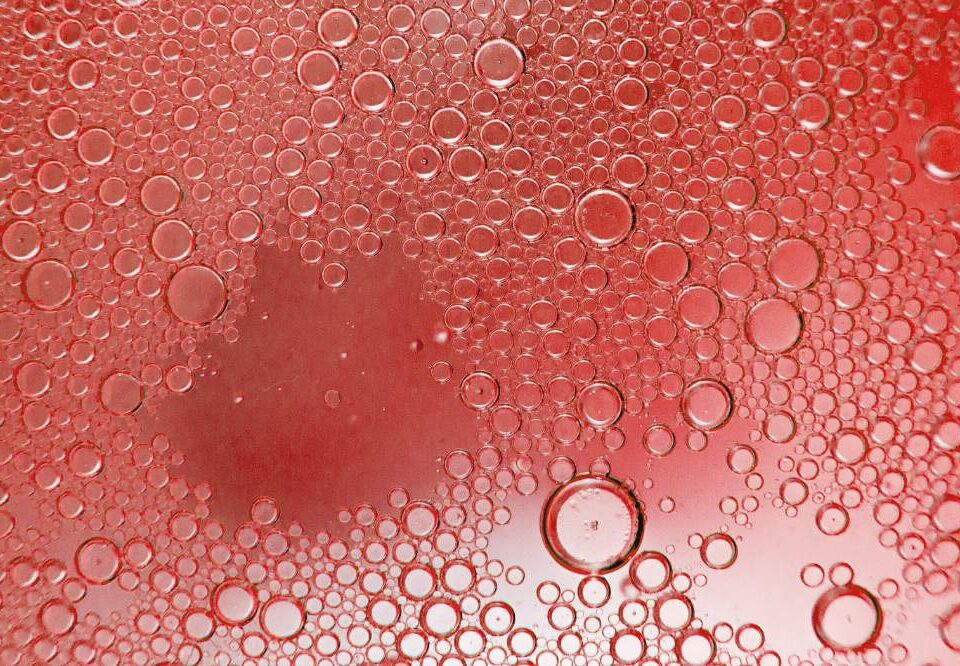
I offer an opportunity...
I also offer you the option—if requested—to apply a hydrophobic coating after cleaning, so you won’t have to worry about maintenance for at least 5 years.
As a bonus, by not using water to clean your panels for such a long time, you’re also doing a lot for the environment!
If your system operates in a dusty or polluted environment, self-cleaning hydrophobic coatings can be especially beneficial.
So, how much does all this cost?
From 8.000 Ft /m2 + VAT
You can also choose...
You can also choose the option of applying a new innovative material during the washing process, called Rivolta P. H.C.
It is a material-friendly, highly effective, and biologically easily degradable cleaning concentrate designed for cleaning contaminants from solar panel systems.
It is based on a combination of special active ingredients, each of which gently removes various residues and performance-inhibiting substances from the modules.
How much does all this cost?
From 1.000 Ft /m2 + VAT
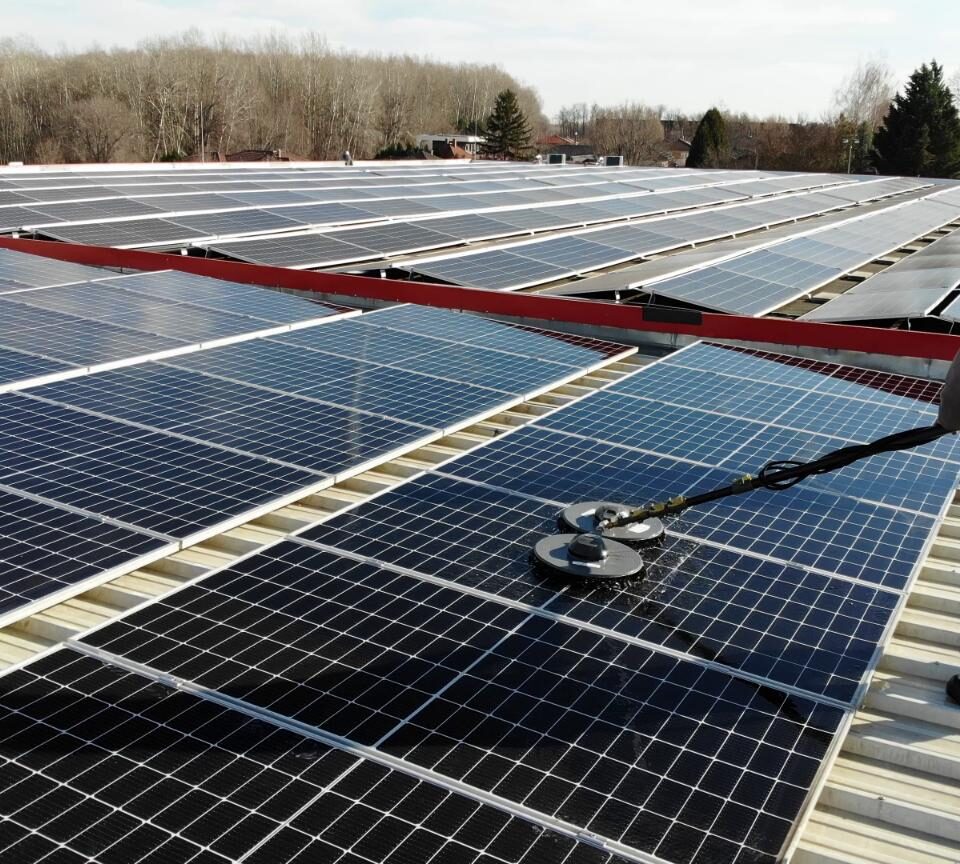
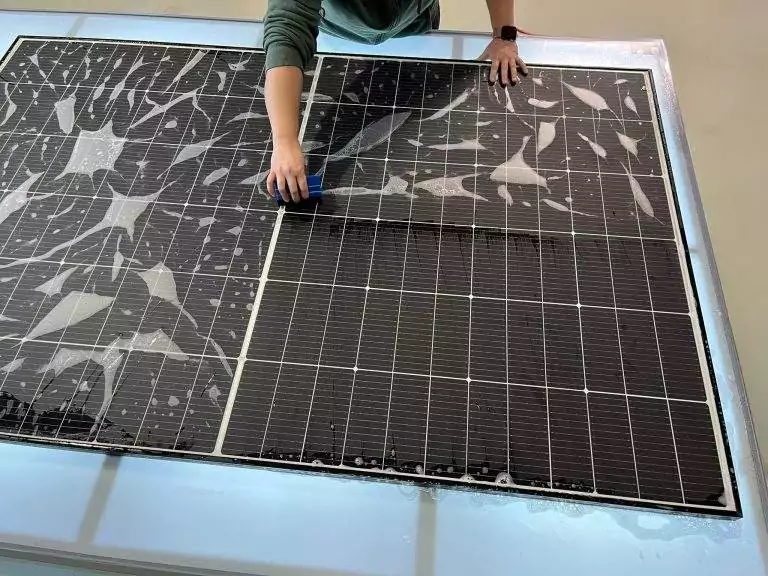
DID YOU HEAR THAT...
Did you hear that from 2028, the EU will require solar panels to be installed on all new residential buildings?
If panels are everywhere, there will definitely be situations where sunlight reflected from your neighbor’s panels could burn your retinas.
This light is extremely intense, and our eyes are not capable of withstanding such exposure for long periods. Light-sensitive cells in the eye can be damaged, and the glare can become disturbing.
At airports, this issue can even pose a serious aviation safety risk!
Leave it to us—we’ll handle that too!
With the application of an innovative anti-reflective film.
From 29.000 Ft /m2 + VAT
Anti-reflective (AR) films are special coatings or films applied to the surface of solar panels to reduce light reflection and increase solar energy absorption, thereby improving panel efficiency. They can be used in both new and existing systems.
How does it work?
Traditional solar panels reflect a portion of sunlight, which reduces the amount of absorbed light and therefore lowers energy production efficiency.
The anti-reflective film:
Reduces light reflection, allowing more sunlight to reach the cells.
Improves light transmission, which increases solar energy conversion efficiency.
Can increase solar panel performance by 3–8%, especially under low-angle light conditions (e.g. in the morning and late afternoon).
Can reduce dirt buildup, as some coatings have hydrophobic properties.
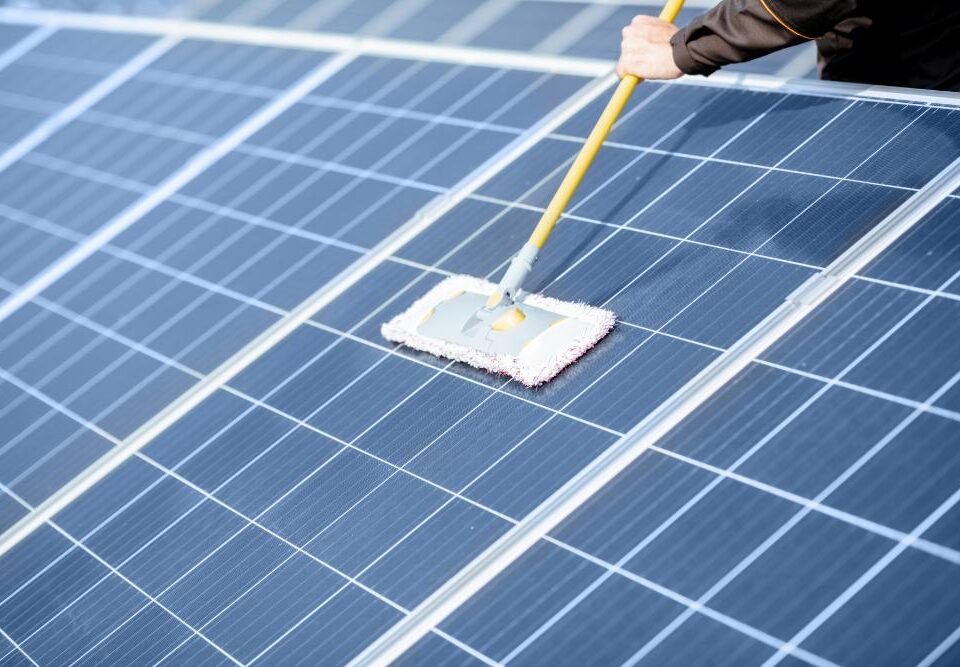
WHY IS DRY CLEANING IMPORTANT?
Dry solar panel cleaning is playing an increasingly important role in the maintenance of solar energy systems, especially in regions where water use is limited or where frequent cleaning makes water-based methods costly and environmentally unsustainable.
Water conservation – Traditional water-based solar panel cleaning can require thousands of liters of water annually for larger systems, while dry cleaning offers a completely water-free solution.
Eco-friendly solution – Waterless cleaning requires no chemicals or large amounts of energy for water pumping and treatment.
Cost-effective – Dry cleaning using robots or electrostatic technology can result in lower long-term maintenance costs, as it eliminates the need for water supply infrastructure.
Special fun fact
The arrival of Saharan dust in Hungary has become more frequent in recent years. For instance, in 2023, air masses filled with Saharan dust reached Hungary as many as 10–12 times, and in some years, up to 16 such events have been recorded.
In 2024, we also experienced multiple instances of Saharan dust influx; for example, in early April, a significant amount of dust arrived in the country.
The exact number of occurrences varies from year to year, and due to climate change, these events may become increasingly common.
If solar panels are operating near highways or busy main roads,
the following issues may arise:
Chemical exposure and corrosion
Acid rain and atmospheric pollutants: Acid rain resulting from exhaust gases (e.g. nitrogen oxides, sulfur dioxide) can damage the protective layer of the panels and the aluminum frame, causing long-term corrosion.
Pollution and efficiency loss
Dust and soot buildup: Dust, tire particles, and soot from road traffic gradually accumulate on the surface of the panels, reducing light transmission and thus decreasing production efficiency.
Oily deposits: Microscopic oil film layers can form on solar panels from vehicle exhaust and engine oil, which are difficult to remove and can impair performance.
Mechanical impacts
Wind-borne particles: Air currents generated by fast-moving vehicles can blow small stones, sand, and dust onto the panels, which over time may cause micro-damage to the glass surface.
Noise and vibration: While not directly affecting efficiency, proximity to highways can expose the system to noise and vibrations, potentially impacting the longevity of electrical connections.
Temperature effects
Increased thermal load: Heat emitted by asphalt and vehicle engines can raise the temperature of the panels, which may reduce their efficiency (solar panels perform less effectively in extreme heat).
Thermal fluctuations and material fatigue: Significant daily temperature variations can accelerate aging in the panels’ seals and connections.
Solutions and recommendations
Frequent cleaning: A more frequent cleaning schedule is required due to contamination, potentially using professional cleaning with deionized water.
Application of protective coatings: Specialized nanotechnology coatings can reduce the extent of deposits and make cleaning easier.
Proper installation angle: A steeper installation angle can help with the natural washing off of dirt.
Installing windbreaks or vegetation: In some cases, plants or protective fences can help reduce dust and other pollutants.
If it’s a specific site, we can also provide a more detailed analysis of the expected level of contamination and the optimal maintenance strategy.
Bee droppings can cause particularly stubborn contamination on the surface of solar panels and are difficult to remove.
There are several reasons for this
Rapid solidification and UV exposure
Solar panels are constantly exposed to sunlight, which quickly dries the bee droppings, causing it to almost “burn” onto the surface. UV radiation can alter the chemical structure of the droppings, making it even more resistant to cleaning.
High sugar and wax content
Bees’ diet primarily consists of nectar and pollen, which naturally contain sugars and wax-like substances. As a result, their droppings are sticky and strongly adhere to the smooth glass surface of solar panels.
Rain resistance
Since bee droppings are not water-soluble, rain cannot effectively wash them off. In fact, once they dry, they become even more difficult to remove.
Strong adhesion even on hydrophobic surfaces.
Solar panels are often coated with a hydrophobic layer that helps water and dust slide off. However, bee droppings contain substances that can stick to these surfaces as well.
Solutions for cleaning
Warm water and mild cleaner: To loosen stubborn stains.
Soft-bristled brush or microfiber cloth cleaning: To avoid scratching.
Low-pressure washer: Can be effective, but care must be taken with the correct water pressure.
Special enzyme or bio-based cleaners: These can help break down the organic materials in the droppings.
If there is a beekeeping area or bee-friendly plants near a solar park, it is advisable to regularly check and periodically clean the panels, as long-term contamination can reduce efficiency.
Bird droppings can pose a significant problem for the operation and lifespan of solar panels.
Here are the main effects:
Hot-spot phenomenon
(formation of hot spots)
Contaminated or shaded cells produce less power while the other cells operate normally. This can lead to overheating, which over time may damage the panels and even cause cracks.
Reduces performance
Bird droppings usually form a thick and opaque layer on the surface of the panels, blocking sunlight. Since solar panels are connected in series, shading even a single cell can cause a significant decrease in performance across the entire system.
Persistent contamination
and aesthetic issues
If the droppings dry, they become difficult to remove, and stains may remain on the surface. Over time, this degrades the appearance of the panels and affects the satisfaction of clients or investors.
Corrosion and coating damage
Bird droppings are acidic, and if they remain on the panel for an extended period, they can damage the protective layer.
Damage to the protective coating can lead to premature aging of the panels and a decrease in efficiency.
What can be done about it?
Regular cleaning: Periodically check and remove bird droppings.
Bird deterrents: Installing spikes or visual deterrents, such as decoy predators.
Self-cleaning coatings: Applying hydrophobic or photocatalytic coatings that prevent dirt buildup.
Adjusting the tilt angle: A steeper tilt allows rain to wash off the dirt more easily.
If bird droppings are a regular issue in the solar park, it’s worth developing an effective cleaning strategy to minimize performance loss.
Atmospheric pollutants from industrial facilities can have a significant impact on the performance and lifespan of solar panels. Below, I will detail the…
...main problems and their effects.
Acid rain and damage caused by chemical reactions.
Sulfur dioxide (SO₂) and nitrogen oxides (NOₓ): These industrial emissions react with the moisture in the atmosphere, creating acid rain.
Damage to the glass coating and aluminum frame: Acidic precipitation can have a corrosive effect on the panels’ protective layer over time, reducing transparency and efficiency.
Effect: The glass’s light transmission capability can deteriorate, and the lifespan of the solar panels may also decrease.
Reduced light transmission and performance loss.
Soot, dust, and other particles: Industrial emissions (e.g. carbon dioxide, sulfur dioxide, nitrogen oxides) are often released into the air along with soot and other solid particles, which settle on the surface of the panels.
Increase in diffuse light: Aerosols in the air reduce direct sunlight, which is crucial for photovoltaic cells, thus decreasing energy output.
Effect: Performance loss of up to 10-20% can occur if the contamination persists and proper cleaning is not carried out.
Temperature rise and hot-spot phenomenon.
Dark contaminants (soot, oil, metal oxides) increase heat absorption, which can lead to the overheating of the panels.
Uneven contamination can cause the formation of hot spots, which can locally damage the cells.
Effect: The rise in operating temperature reduces the panels’ efficiency and accelerates aging processes.
Oily and greasy deposits
In industrial facilities, oily and greasy aerosols are often produced, which can form a thin, sticky layer on the surface of the panels.
These contaminants are particularly problematic because conventional rain and self-cleaning are insufficient for their removal.
Effect: Due to the “soiling” of the panels, significant energy yield loss can occur.
Solutions to reduce the effects of industrial contamination:
Frequent and targeted cleaning: Solar panels located near industrial areas need to be cleaned more often (even monthly).
The use of mild acidic or specialized industrial cleaners can be effective.
Application of self-cleaning coatings: Hydrophobic and photocatalytic coatings can reduce the level of deposits and make cleaning easier.
Protective covers and optimizing the tilt angle: A steeper tilt can help rain wash off the contaminants more easily.
In certain industrial areas, protective roofs or glass coverings may also be considered.
Regular monitoring and maintenance: Monitoring performance data can help detect any decrease caused by contamination in a timely manner.
Among the crops grown in agriculture, wind-pollinated plants release the most pollen, as these plants deliver their pollen to the stigma not with the help of insects, but by the wind.
The largest pollen producers are the following:
Rye
(Secale cereale)
Wind-pollinated grain, which has an especially high pollen release rate.
Corn
(Zea mays)
One of the most significant pollen sources, it releases a huge amount of fine pollen that can travel several kilometers in the air.
Barley
(Hordeum vulgare)
Also wind-pollinated, it produces a large amount of pollen.
Wheat
(Triticum spp.)
Although to a lesser extent, it can be a significant pollen source during the flowering period.
Sunflower
(Helianthus annuus)
Although an insect-pollinated plant, it produces a large amount of pollen that can cause allergies.
Sorghum
(Sorghum spp.)
Similar to corn, it is a significant pollen-producing plant.
RAPESEED
(Brassica napus)
A high pollen-yielding plant, which is also important for bees.
Alfalfa
(Medicago sativa)
In addition to pollinating, it can also produce a significant amount of pollen.
A preview of our references.
Fun facts
Electrostatic Repulsion Technology
Researchers at the Massachusetts Institute of Technology (MIT) have developed an innovative solution based on the principle of electrostatic repulsion. The surface of the solar panels is laminated with a special film that creates an electric field, causing dust particles to be repelled from the surface. This method keeps the panels clean without the use of water, reducing maintenance costs and increasing efficiency.
Ceramic-based anti-reflective (AR) coating for solar panels
The ceramic-based anti-reflective (AR) coating is a special layer applied to the surface of solar panels to reduce light reflection and enhance the efficient absorption of solar energy. These layers provide a harder, more durable, and resistant alternative compared to traditional silicon dioxide (SiO₂) or other polymer-based coatings.
How does it work?
The ceramic-based AR layer enhances the performance of solar panels through its physical and optical properties:
Optical refractive index control:
The layer is made of materials whose optical index is positioned between that of air and glass, minimizing light reflection.
Increased light transmission:
It reduces light reflection across the broad spectrum of sunlight, thereby increasing light absorption and energy conversion efficiency.
Hydrophobic and self-cleaning properties:
Some types have water-repellent and dirt-resistant properties, reducing the accumulation of dust and other contaminants.
What is it made of?
Ceramic-based AR layers typically contain the following materials:
✔ Silicon nitride (Si₃N₄) – A highly durable, chemically stable material that offers excellent resistance to mechanical impacts.
✔ Titanium dioxide (TiO₂) – A coating with high light transmission and UV resistance.
✔ Aluminum oxide (Al₂O₃) – Excellent resistance to corrosion and contamination buildup.
✔ Zirconium oxide (ZrO₂) – A hard and wear-resistant layer that increases the mechanical durability of the solar panel.
Nanotechnology coatings for solar panels – brief summary
Nanotechnology coatings are ultra-thin layers applied to the surface of solar panels to increase energy efficiency and provide protection against contaminants. These innovative coatings work at the molecular level, reducing light reflection, increasing light transmission, and preventing the adhesion of dust, water, or other impurities.
HOW DO THEY WORK?
Nanotechnology coatings optimize physical and chemical properties:
✔ Anti-reflective properties – Reduces sunlight reflection, increasing the light absorption and performance of the panels.
✔ Self-cleaning effect – Hydrophobic and oleophobic coatings repel water, oil, and dust, reducing contamination buildup.
✔ UV and weather resistance – Extends the lifespan of solar panels by protecting them from the harmful effects of sunlight, rain, and contaminants.
✔ Mechanical protection – Some nanocoatings make the glass surface of solar panels more scratch-resistant.
Advantages and applications
✔ Reduced cleaning costs – Less frequent maintenance of solar panels.
✔ Higher efficiency – Reduced reflection and the self-cleaning effect ensure optimal performance for longer periods.
✔ More durable solar panels – Protects the glass surface and reduces damage caused by weather conditions.
Application
• For residential and industrial solar panels to increase efficiency and reduce maintenance costs.
• In desert, industrial, and highly polluted areas, where dust, sand, and other contaminants frequently accumulate.
• In marine and coastal regions, where salty air can quickly damage the surface of solar panels.
FAQ
- Why is regular cleaning of solar panels necessary? Contaminants such as dust, pollen, bird droppings, or air pollution can reduce the efficiency of solar panels. Regular cleaning helps maximize performance and extend the lifespan of the panels.
-
How often should solar panels be cleaned?
It is recommended to clean them at least twice a year—once in spring and once in autumn. In particularly polluted areas, more frequent cleaning may be necessary. -
How is the solar panel cleaning process carried out?
Cleaning is done using specially designed cleaning agents, soft brushes, and deionized water to prevent surface scratching. -
What are the benefits of professional solar panel cleaning?
Professional cleaning ensures the complete removal of contaminants, maintaining optimal panel performance and extending their service life. -
Under what weather conditions can cleaning be performed?
Ideally, cleaning should be done in dry, overcast weather to avoid sudden temperature changes that could damage the panel surface. -
Can solar panels be cleaned by the owner?
It is possible, but to avoid damage and ensure effective cleaning, it is recommended to seek professional help with the proper equipment and experience. -
How long does it take to clean solar panels?
This depends on the number and placement of the installed panels. Cleaning a typical household system usually takes 1–2 hours. -
Does cleaning affect the warranty?
Proper cleaning does not affect the warranty. In fact, regular maintenance is often viewed favorably by manufacturers when addressing warranty issues.









